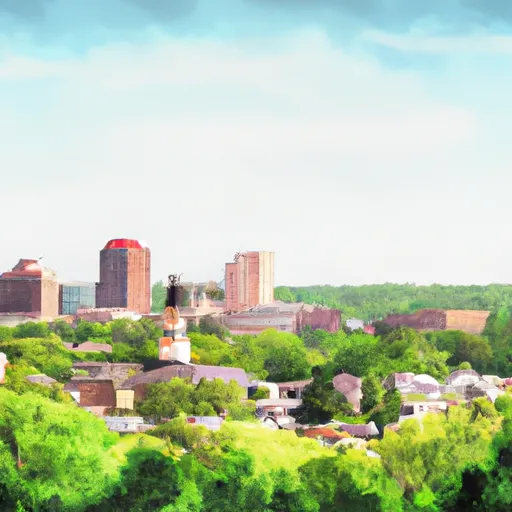-
 Snoflo Premium
Snoflo Premium
Get unlimited access to all our content
With no Ad interruptions! - Start Your Free Trial Login with existing account
Spring-Grove
Eden Index
Climate
6.4
•
Recreation
1.8
•
Community
2.2
•
Safeguard
3.8/10

Spring Grove is a small town located in southeastern Minnesota, known for its picturesque landscapes and outdoor recreational opportunities. The climate in Spring Grove is characterized by warm summers and cold winters. The average high temperature in July is around 82°F (28°C), while January temperatures often drop to 21°F (-6°C). Spring Grove receives an average annual precipitation of 32 inches, with snowfall during winter months.
The town is surrounded by scenic water bodies, including the Root River and several creeks, making it a haven for water enthusiasts. These hydrological features also contribute to the diverse wildlife found in the area. Outdoor recreation opportunities abound in Spring Grove, with activities such as fishing, kayaking, and canoeing being popular along the waterways. Anglers can catch a variety of fish species, including trout, bass, and catfish.
In addition to water activities, Spring Grove offers ample opportunities for hiking and biking. The Harmony-Preston Valley State Trail runs nearby, providing a scenic route for outdoor enthusiasts to explore. With its favorable climate, diverse hydrology constituents, and varied outdoor recreation options, Spring Grove is a delightful destination for nature lovers and adventure seekers alike.
What is the Eden Index?
The Snoflo Eden Index serves as a comprehensive rating system for regions, evaluating their desirability through a holistic assessment of climate health, outdoor recreation opportunities, and natural disaster risk, acknowledging the profound impact of these factors on livability and well-being.
Climate Health Indicator (CHI): 6.4
Spring-Grove receives approximately
870mm of rain per year,
with humidity levels near 82%
and air temperatures averaging around
7°C.
Spring-Grove has a plant hardyness factor of
4, meaning
plants and agriculture in this region thrive during a short period during spring and early summer. Most
plants will die off during the colder winter months.
By considering the ideal temperature range, reliable water supplies, clean air, and stable seasonal rain or snowpacks, the Climate Health Indicator (CHI) underscores the significance of a healthy climate as the foundation for quality living.
A healthy climate is paramount for ensuring a high quality of life and livability in a region, fostering both physical well-being and environmental harmony. This can be characterized by ideal temperatures, reliable access to water supplies, clean air, and consistent seasonal rain or snowpacks.
Weather Forecast
Streamflow Conditions
Upper Mississippi-Black-Root
Area Rivers
Upper Mississippi-Black-Root
Snowpack Depths
Upper Mississippi-Black-Root
Reservoir Storage Capacity
Upper Mississippi-Black-Root
Groundwater Levels
Recreational Opportunity Index (ROI): 1.8
The Recreational Opportunity Index (ROI) recognizes the value of outdoor recreational options, such as parks, hiking trails, camping sites, and fishing spots, while acknowledging that climate plays a pivotal role in ensuring the comfort and consistency of these experiences.
Access to outdoor recreational opportunities, encompassing activities such as parks, hiking, camping, and fishing, is crucial for overall well-being, and the climate plays a pivotal role in enabling and enhancing these experiences, ensuring that individuals can engage in nature-based activities comfortably and consistently.
Camping Areas
| Campground | Campsites | Reservations | Toilets | Showers | Elevation |
|---|---|---|---|---|---|
| Alley Spring - Ozark National Scenic River | 162 | 672 ft | |||
| Graham Cave State Park | None | 778 ft | |||
| Rollins Ferry Access - MDC | 11 | 568 ft | |||
| Paydown Access - MDC | 6 | 596 ft | |||
| Chamois Access - MDC | 4 | 530 ft | |||
| Pulltite - Ozark National Scenic River | 55 | 817 ft | |||
| Montauk State Park | None | 910 ft | |||
| Hermann City RV Park | 20 | 509 ft | |||
| Akers | None | 818 ft | |||
| Lane Spring | 64 | 1,069 ft |
Nearby Ski Areas
Catastrophe Safeguard Index (CSI):
The Catastrophe Safeguard Index (CSI) recognizes that natural disaster risk, encompassing floods, fires, hurricanes, and tornadoes, can drastically affect safety and the overall appeal of an area.
The level of natural disaster risk in a region significantly affects safety and the overall livability, with climate change amplifying these risks by potentially increasing the frequency and intensity of events like floods, fires, hurricanes, and tornadoes, thereby posing substantial challenges to community resilience and well-being.
Community Resilience Indicator (CRI): 2.2
The Community Resilience Indicator (CRI) recognizes that education, healthcare, and socioeconomics are crucial to the well-being of a region. The CRI acknowledges the profound impact of these elements on residents' overall quality of life. By evaluating educational resources, healthcare accessibility, and economic inclusivity, the index captures the essential aspects that contribute to a thriving community, fostering resident satisfaction, equity, and social cohesion.

